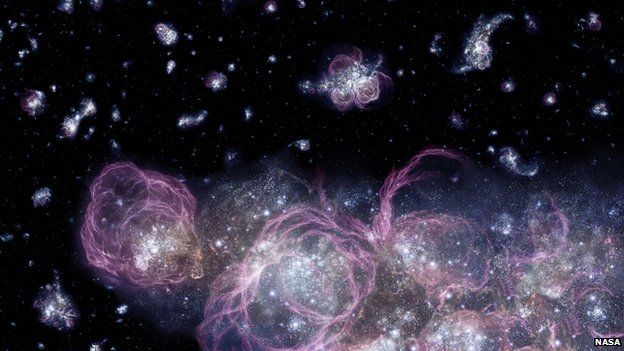Hints of elusive early stars found
- Published

Astronomers may have discovered the signature of one of the Universe's earliest stars.
Theoretical models predict that some of the very first stars were hundreds of times larger than the Sun.
But no clear evidence of this had been found so far.
Scientists writing in the journal Science have discovered the traces of an early massive stellar object in the exceptional chemical composition of a star in our galaxy.
"This is quite a unique star, with a very peculiar chemical pattern that has never been found previously," said lead author Dr Wako Aoki, from the National Observatory of Japan.
In the first several hundred million years after the Big Bang, the Universe was composed only of hydrogen and helium. It had no structure, no stars, nor any black holes.
"It was a very featureless, boring Universe. Then the first stars formed and fundamentally transformed it," said Dr Volker Bromm from the University of Texas, Austin.
Dr Bromm, who was not part of the study, has worked for many years on numerical simulations of early star and galaxy formation.
"How this happened, this transformation of the early Universe into a state of ever increasing complexity, depended very much on the mass of the first stars."
Nuclear fusion occurring in the core of these first generation stars produced the heavier elements that we know today, like carbon, oxygen, magnesium and iron.
The stars eventually died, creating explosions - supernovas - that dispersed heavy elements throughout space.
Then the second generation of stars grew out of the gas that already contained some elements other than hydrogen and helium.
The star found by Dr Aoki's team, named SDSS J0018-0939, is one of hundreds identified by the Sloan Digital Sky Survey with 1,000 times less iron than that found in our Sun.
Astronomers call them low-metallicity stars.
Using the Japanese Subaru telescope, the researchers produced high-resolution "spectra" of 150 stars in the sample, by breaking down the light into different wavelengths.
They found one star in our galaxy with a very peculiar chemical composition.
Lead author Dr Aoki explained: "[From the spectra] we needed to identify the absorption of light by individual elements."
When the light was broken down, some of the colours were missing. Each missing colour represents a wavelength that can only be absorbed by a particular element. This way the scientists know what elements are present in the stars.
At the moment there is no way to directly observe the very first stars, so scientists rely on indirect probes. They investigate the chemical composition of ancient, extremely metal-poor stars to infer the properties of the first supernova explosions - "stellar archaeology".
Dr Bromm told BBC News: "You have a massive star which eventually runs out of nuclear fuel and then gravity takes over, creating in the centre either a neutron star or a black hole."
"Most of the matter will go into the black hole, which means that most of the heavy metals will also end up in the black hole."
But theory predicts that beyond 100 solar masses, stars would suffer a completely different type of explosion called a Pair-Instability supernova in which no physical remnant is left.
These are very unusual, hyper-violent blasts. "It's a huge thermonuclear explosion; All the fuel is burnt at once and the star rips itself apart."
In this case, all the elements produced by the star are ejected, creating a surrounding region that is rich in metals.
Dr Aoki added: "We studied stars with extremely low metallicity, but the iron abundance of this star is not as low." This was the first indication that the life of the progenitor star must have ended in a Pair-Instability supernova, which can only happen in massive stars.
A second clue was the extremely low abundance of the elements barium and strontium. Massive stars explode before they can create such heavy elements.
In our present Universe, stars that are 100 times more massive than the Sun are extremely rare. The presence of more metals limits the size of a star.
As supernovas populated the cosmos with metals, the birth of huge stars became more infrequent.
Looking into the past
Many more observations are planned for the coming years, in a search for other primitive stars.
"Next generation large telescopes may catch the light of such very massive stars", said Dr Aoki.
"But we don't know whether a large number of massive stars really exists or not."
Huge stars have a short life of "only" three million years, which is a thousand times shorter than what is expected for the Sun. Therefore, none of the earliest large stars will have survived to the present day.
"There is no possibility to find such stars in our galaxy. We need to observe very distant galaxies," said Dr Aoki.
Astronomers can look into the Universe's past by pointing telescopes at the farthest objects, since light emitted by them takes billions of years to reach Earth.
Nasa's James Webb Space Telescope is planned as the successor to the Hubble Space Telescope. It will be launched in 2018 to look at the end of the cosmic "dark ages".
Dr Bromm is very excited about the new telescope: "We have two complementary windows. We can look at stars at very high redshift and the local descendants, the local fossils."
The redshift is a measure of the way light is stretched by the expansion of the Universe and is used by scientists to calculate cosmic distances. The higher the redshift, the farther the object is.
This new discovery, together with the future observations, will help astronomers to finally sample the entire history of star formation, including how the different chemical elements that produced life on Earth came to be.
- Published7 May 2014
- Published20 January 2014
- Published28 October 2009